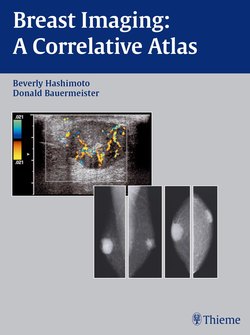Читать книгу Breast Imaging - Beverly Hashimoto - Страница 26
На сайте Литреса книга снята с продажи.
ОглавлениеCase 12
Case History
A 32-year-old woman presents with a new left breast lump. She is diabetic and has been insulin dependent since childhood.
Physical Examination
• left breast: large hard mass at the 3:00 position
• right breast: normal exam
Mammogram
Mass (Fig. 12–1)
• margin: circumscribed
• shape: oval
• density: high density
Figure 12–1. In the 3:00 to 4:00 position of the left breast, there is a circumscribed oval mass that corresponds to the palpable mass designated by the metallic marker. (A). Left MLO mammogram. (B). Left CC mammogram.
Ultrasound
Low Frequency
Frequency
• 8 MHz
Mass
• margin: ill defined
• echogenicity: hypoechoic
• retrotumoral acoustic appearance: severe shadowing, mass completely obscured
• shape: irregular (Fig. 12–2)
Figure 12–2. Left radial breast sonogram: Examination of the same mass as Figure 12–3 demonstrates that as the frequency decreases, the mass attenuates the sound less so the internal details of the mass becomes more apparent. The mass has a predominantly hyperechoic periphery with multiple linear lucencies centrally.
High Frequency
Frequency
• 13 MHz
Associated Findings
Lower frequency is more informative than high frequency for masses that severely attenuate sound because the internal architecture of the shadowing lesion is better displayed with the lower frequency. (See Fig. 12–3.)
Figure 12–3. Left radial breast sonogram: With high frequency, the palpable mass attenuates the sound so only a heavily shadowing area is evident.
Pathology
• diabetic mastopathy
Management
• BI-RADS Assessment Category 4, suspicious; biopsy should be considered
Pearls and Pitfalls
1. Occasionally diabetes will affect the breast causing diabetic mastopathy. Microscopically, diabetic mastopathy consists of perivasculitis, keloid-like fibrosis, and ductitis and/ or lobulitis. Clinically, this abnormality presents as a hard breast mass. The palpable mass cannot be distinguished from malignancy. However, this presentation in a young woman who has had long-term insulin dependence should be a strong clue to the diagnosis.
2. The mammographic findings of diabetic mastopathy include a diffusely dense breast, asymmetric focal density, an irregular mass, and less commonly a circumscribed mass.
3. Sonographically, the fibrosis strongly attenuates sound, so usually only shadowing is evident. With very low frequencies, the internal architecture of the mass is identified.
Suggested Readings
1. Boullu S, Andrac L, Piana L, Darmon P, Dutour A, Oliver C. Diabetic mastopathy, complication of type 1 diabetes mellitus: report of two cases and a review of the literature. Diabete Metab 1998;24:448–454.
2. Byrd BF, Hartmann WH, Graham LS, Hoble HH. Mastopathy in insulin-dependent diabetics. Ann Surg 1987;205:529–532.
3. Hunfeld KP, Bassler R. Lymphocytic mastitis and fibrosis of the breast in long-standing insulin-dependent diabetics. Gen Diagn Pathol 1997;143:49–58.
4. Pluchinotta AM, Talenti E, Lodovichetti G, Tiso E, Biral M. Diabetic fibrous breast disease: a clinical entity that mimics cancer. Eur J Surg Oncol 1995;21:207–209.
5. Seidman JD, Schnaper LA, Phillips LE. Mastopathy in insulin-requiring diabetes mellitus. Hum Pathol 1994;25:819–824.
